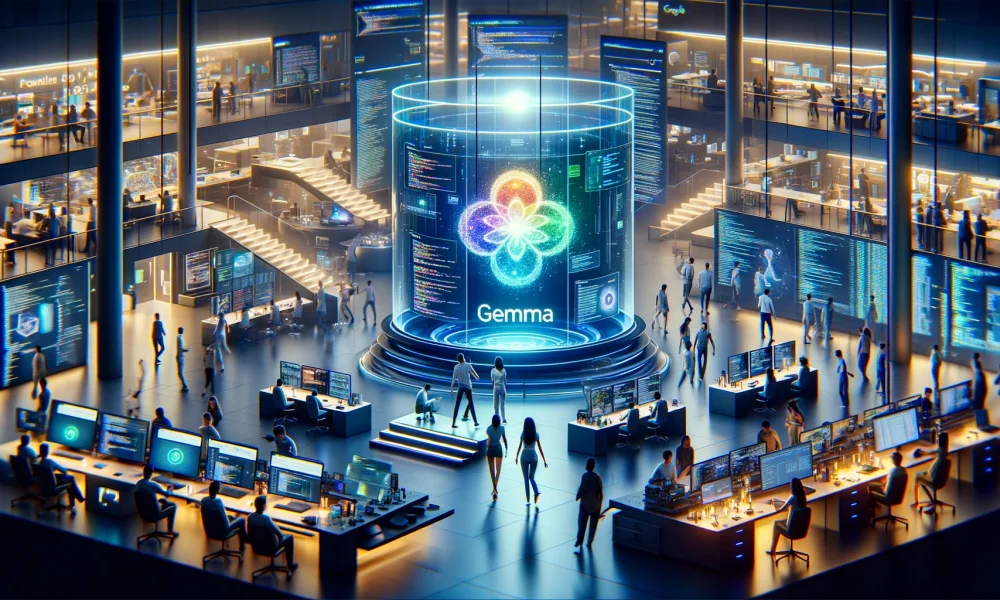Google recently introduced Gemma, an open-source language model that shares its technological foundation with Gemini, Google’s highly advanced AI. Named after the Latin term for “precious stone,” Gemma is designed to be a more accessible counterpart to its predecessor, Gemini 1.5, while still maintaining a balance between high performance and responsible use. This moves towards open-source generative AI underlines Google’s commitment to democratizing AI technology, allowing for wider application and innovation in the field. The article sheds light on Gemma’s distinctive characteristics and how it sets itself apart from two of the leading open-source AI models in the market, Meta’s Llama 2 and Mistral’s Mistral 7B.
Gemma: A New Leap in AI Language Models
Gemma is a family of lightweight, open-source language models, available in 2 billion and 7 billion parameter configurations to suit a wide range of computational needs. It can be deployed across various platforms, including GPUs, TPUs, CPUs, and on-device applications, showcasing its versatility. Gemma’s architecture leverages advanced neural network techniques, particularly the transformer architecture, a backbone of recent AI developments.
What sets Gemma apart is its exceptional performance in text-based tasks, outperforming competitors in 11 out of 18 academic benchmarks. It excels in language understanding, reasoning, question answering, commonsense reasoning, and specialized domains like mathematics, science, and coding. This performance highlights Gemma’s significant contribution to the evolution of language models.
Key Features
Gemma introduces a range of features designed to facilitate easier access and integration into various AI development frameworks and projects:
- Cross-Framework Compatibility: Gemma offers toolchains for inference and supervised fine-tuning that are compatible with major development frameworks like JAX, PyTorch, and TensorFlow via native Keras 3.0. This ensures developers can utilize their preferred tools without facing the hurdles of adapting to new environments.
- Access to Ready-to-Use Resources: Gemma is equipped with Colab and Kaggle notebooks for immediate use, along with integrations with popular platforms such as Hugging Face and NVIDIA NeMo. These resources aim to simplify the process of starting with Gemma for both new and experienced developers.
- Flexible and Optimized Deployment: Gemma is designed for use on a variety of hardware, from personal devices to cloud services and IoT devices, optimized for AI hardware, ensuring top performance across devices. It also supports easy deployment options, including Vertex AI and Google Kubernetes Engine.
- Commitment to Responsible AI: Emphasizing secure and ethical AI development, Gemma incorporates automated data filtering, reinforcement learning from human feedback, and comprehensive testing to uphold high standards of reliability and safety. Google also offers a toolkit and resources to aid developers in maintaining responsible AI practices.
- Encouraging Innovation through Favorable Terms: Gemma’s terms of use support responsible commercial applications and innovation, offering free credits for research and development, including access to Kaggle, a free tier for Colab notebooks, and Google Cloud credits to empower researchers and developers to explore new frontiers in AI.
Comparison with Other Open-Source Models
- Gemma Vs Llama 2: Gemma and Llama 2, developed by Google and Meta respectively, showcase their unique strengths within the domain of open-source language models, catering to different user needs and preferences. Gemma is particularly optimized for tasks in the STEM fields, such as code generation and mathematical problem-solving, making it a valuable resource for researchers and developers who require specialized functionalities, especially on NVIDIA platforms. Conversely, Llama 2 appeals to a broader audience with its versatility in handling a range of general language tasks, including text summarization and creative writing. The specialized focus of Gemma on STEM-related tasks might narrow its broader applicability in varied real-world scenarios, while the high computational demands of Llama 2 could hinder its accessibility for users with limited resources. These distinctions underline the diverse applications and potential limitations of AI technologies, reflecting their separate paths towards contributing to the progress and challenges in the digital era.
- Gemma 7B Vs Mistral 7B: While both the Gemma 7B and Mistral AI’s Mistral 7B models are categorized as lightweight, open-source language models, they excel in different domains. Gemma 7B stands out for its capabilities in code generation and mathematical problem-solving, whereas Mistral 7B is recognized for its logical reasoning skills and handling of real-world situations. Despite these differences, the two models offer similar levels of performance when it comes to inference speed and latency. Mistral 7B’s fully open-source nature allows for more straightforward modifications compared to Gemma 7B. This difference in accessibility is further emphasized by Google’s requirement for users to agree to certain terms before they can utilize Gemma, aiming to ensure robust safety and privacy measures. In contrast, Mistral AI’s approach might present challenges in enforcing similar standards.
The Bottom Line
Google’s Gemma represents a significant stride in open-source generative AI, offering a versatile and accessible language model designed for both high performance and responsible use. Standing on the technological prowess of Google’s advanced AI, Gemini, Gemma is tailored to democratize AI technology, encouraging wider application and innovation. With configurations designed to meet diverse computational needs and a suite of features that ensure ease of access, cross-framework compatibility, and optimized deployment, Gemma sets a new standard in the AI domain. Its exceptional performance in specialized STEM tasks distinguishes it from competitors like Meta’s Llama 2 and Mistral AI’s Mistral 7B, each with their unique strengths. However, Gemma’s comprehensive approach to responsible AI development and its support for innovation through favorable terms of use highlight Google’s commitment to advancing AI technology in an ethical and accessible manner.


classicfurs.net / 2024-03-06 17:11:30




